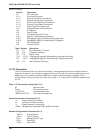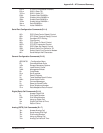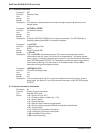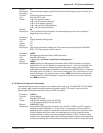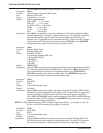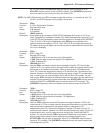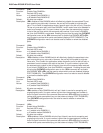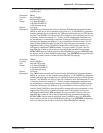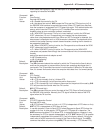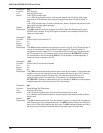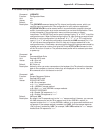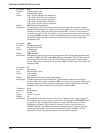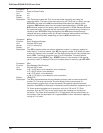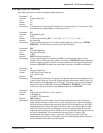
RASFinder RF300E/RF310E User Guide
RF300E/RF310E130
D.1.4 Serial Port Configuration Commands
Use the following commands to control the interaction between the TA and the computer/terminal that
is connected to it.
Command: &Cn
Function: DCD Control
Unit: Decimal ASCII code
Values: n=0—DCD is forced high at all times.
n=1—DCD goes from low to high when the TA establishes a connection (DCD
normal).
n=2—DCD drops briefly following a disconnect, then goes high again. S-register S10
defines how long the DCD signal remains low after a disconnect.
Default: &C1 (DCD normal)
Description: The &Cn command controls the behavior of the DCD (Data Carrier Detect) signal
(pin 8 on the RS232E/V.24 interface). Normally, DCD goes high when the TA
establishes a connection, and drops when the connection is lost. However, you can
also force DCD to remain high at all times, or to remain high except for a brief drop
following a disconnect.
Command: &Dn
Function: DTR Control
Unit: Decimal ASCII code
Values: n=0—The TA ignores the DTR signal.
n=1—When DTR goes low, the TA exits data mode and re-enters AT command
mode.
n=2—If DTR goes low when the TA is online, then the TA hangs up, returns to
command mode, and disables auto-answer. If the TA is offline, it neither answers nor
dials while DTR is low.
n=3—When DTR goes low, the TA resets the data port and disables auto-answer. If
DTR goes low when the TA is online, then the TA hangs up, resets the active
configuration to the stored configuration, and disables auto-answer.
n=4—Ignore DTR only when answering a data call. If DTR is low when an incoming
data call is present, then the TA will answer the call. If DTR goes high during that
call, nothing will happen. However, if DTR goes high and then drops for the minimum
time specified by S25, then the call will be disconnected just as it would
with &D1. &D4 is the same as &D1, except that &D4 can answer a data call without
DTR and DTR can remain low for the duration of the call, but if DTR goes high, then
&D4 will behave like &D1.
Default: &D1 (exit data mode and re-enter AT command mode)
Description: The &Dn command controls how the TA responds to the DTR (Data Terminal Ready)
signal on pin 20 of the RS232E/V.24 interface. A high DTR signal tells the TA that the
connected computer is ready to communicate. If a call is to be accepted while DTR is
low, then the TA must be configured to ignore DTR (&D0 or &D4). If this configuration
setting is not made, the TA rejects incoming calls until DTR is high when the call is
received.
Command: $Dn
Function: Persistent DTR Dialing
Unit: Decimal ASCII code
Values: n=0—disable,
n=1—enable
Default: $D0 (disabled)
Description: The $Dn command enables or disables Persistent DTR Dialing (PDD). PDD causes
the terminal adapter to automatically and continuously redial stored telephone
number 0 when the port has no active calls and DTR is high. The delay after a call
disconnects (returning to the idle state) yet DTR is still high is controlled by S-
register S80. Also, once DTR changes from low to high, then a delay set by S80 will



